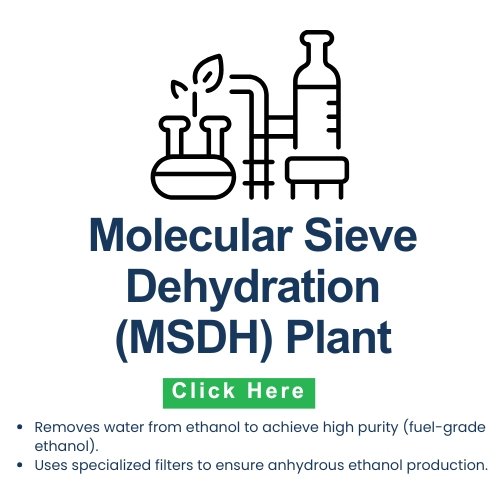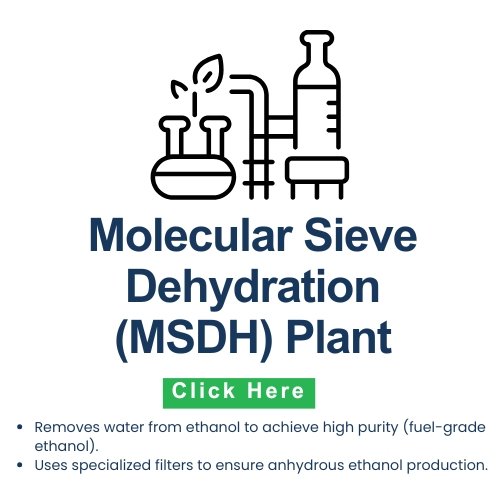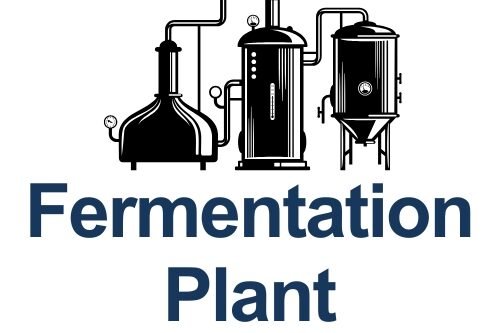dehydration system offers a highly efficient and energy-saving method for producing anhydrous ethanol, which is essential for blending with gasoline and various industrial applications.
Table of Contents
Introduction
Molecular Sieve Dehydration (MSDH) is an essential process in ethanol production, used to remove water from hydrous ethanol and achieve high-purity anhydrous ethanol (99.5%+). This method is preferred over traditional azeotropic distillation due to its higher efficiency, lower energy consumption, and cost-effectiveness.
By understanding the working principles, calculations, and performance optimization techniques of MSDH, ethanol producers can significantly improve plant efficiency and output quality. This article covers the step-by-step process, essential formulas, and calculations used in industrial ethanol dehydration.
How Does Molecular Sieve Dehydration Work?
Step-by-Step Process of MSDH:
- Hydrous Ethanol Feed:
- Ethanol with 4-5% water content is preheated and fed into the dehydration unit.
- Adsorption Phase:
- Ethanol vapor passes through molecular sieve beds filled with synthetic zeolites.
- The zeolite pores selectively trap water molecules while allowing ethanol to pass.
- Dehydrated Ethanol Collection:
- The exiting ethanol is 99.5%+ pure anhydrous ethanol.
- The purified ethanol is condensed and sent for storage or further processing.
- Regeneration Phase:
- Molecular sieves become saturated with water and need regeneration.
- A vacuum or hot gas purge is applied to remove water from the sieve pores.
- The sieves regain their adsorption capacity and are ready for the next cycle.
- Continuous Operation:
- The system operates in parallel cycles, ensuring uninterrupted ethanol production.

Key Components of an MSDH Plant
- Molecular Sieve Beds: Contain synthetic zeolites (3A or 4A sieves) that adsorb water.
- Hydrous Ethanol Feed System: Supplies the ethanol mixture for dehydration.
- Regeneration System: Uses hot purge gas or vacuum desorption to remove trapped water.
- Control Unit: Manages process parameters for maximum efficiency.
Molecular Sieve Dehydration (MSDH) Plant Calculations
For ethanol dehydration, several calculations are used to determine efficiency, sieve capacity, and overall ethanol purity. Below are the key formulas used in the process:
1. Water Removal Efficiency Calculation
This formula calculates how efficiently the MSDH plant removes water from ethanol. Efficiency=Wi−WfWi×100\text{Efficiency} = \frac{W_i – W_f}{W_i} \times 100
Where:
- WiW_i = Initial water content in ethanol (kg)
- WfW_f = Final water content in ethanol (kg)
Example Calculation:
If the initial water content in a batch of 1000 kg ethanol is 5% (50 kg water) and the final ethanol purity is 99.5% (5 kg water remaining): Efficiency=50−550×100=90%\text{Efficiency} = \frac{50 – 5}{50} \times 100 = 90\%
Thus, the water removal efficiency of the molecular sieve plant is 90%.
2. Adsorption Capacity of Molecular Sieves
This equation helps determine how much water a given quantity of molecular sieves can adsorb. Q=MCQ = \frac{M}{C}
Where:
- QQ = Adsorption capacity (kg water/kg sieve)
- MM = Mass of adsorbed water (kg)
- CC = Mass of molecular sieves (kg)
Example Calculation:
If 500 kg of molecular sieve is used and it adsorbs 125 kg of water: Q=125500=0.25 kg water per kg sieve Q = \frac{125}{500} = 0.25 \text{ kg water per kg sieve}
This means each kg of sieve can hold 0.25 kg of water.
3. Required Molecular Sieve Quantity
To determine how much molecular sieve is needed to process a given ethanol batch: C=MQC = \frac{M}{Q}
Where:
- CC = Required molecular sieve mass (kg)
- MM = Mass of water to be removed (kg)
- QQ = Adsorption capacity of the sieve (kg water/kg sieve)
Example Calculation:
If 200 kg of water needs to be removed and each kg of sieve holds 0.25 kg water: C=2000.25=800 kg of molecular sieveC = \frac{200}{0.25} = 800 \text{ kg of molecular sieve}
Thus, 800 kg of molecular sieves is required for this process.
4. Ethanol Purity Calculation
This formula calculates the final ethanol purity after dehydration. Purity(%)=(Anhydrous Ethanol OutputTotal Output)×100\text{Purity} (\%) = \left( \frac{\text{Anhydrous Ethanol Output}}{\text{Total Output}} \right) \times 100
Example Calculation:
If after dehydration, 990 kg of ethanol is collected from an initial 1000 kg batch: Purity=(9901000)×100=99%\text{Purity} = \left( \frac{990}{1000} \right) \times 100 = 99\%
Thus, the ethanol purity achieved is 99%.
Advantages of Molecular Sieve Dehydration
- Higher Purity: Achieves 99.5%+ ethanol purity
- Energy Efficient: Requires less energy compared to azeotropic distillation
- Continuous Operation: Ensures uninterrupted ethanol production
- Lower Operating Costs: Minimal chemical use, reducing costs
- Environmentally Friendly: No hazardous by-products
Some reputable resources related to Molecular Sieve Dehydration (MSDH) Plant calculations:
- Ethanol Production & Dehydration Process – U.S. Department of Energy
- Molecular Sieve Adsorption Technology – ScienceDirect
- Industrial Ethanol Dehydration Techniques – ResearchGate
- Zeolite Molecular Sieves & Their Applications – Zeochem
- Sustainable Biofuel Production & Dehydration – National Renewable Energy Laboratory (NREL)
Conclusion
Molecular Sieve Dehydration (MSDH) is the most efficient method for producing high-purity ethanol. By using advanced adsorption and regeneration techniques, ethanol manufacturers can maximize efficiency, reduce costs, and ensure high-quality ethanol production.
By applying these key formulas and calculations, plant operators can optimize performance and minimize losses.
Frequently Asked Questions (FAQs)
1. What type of molecular sieve is used for ethanol dehydration?
Molecular sieves 3A and 4A are commonly used due to their ability to selectively adsorb water molecules.
2. How often should molecular sieves be replaced?
With proper regeneration cycles, molecular sieves can last 3-5 years before needing replacement.
3. Why is molecular sieve dehydration better than azeotropic distillation?
MSDH requires less energy, eliminates chemical use, and provides higher ethanol purity compared to azeotropic distillation.
4. How much ethanol can be purified in one MSDH cycle?
This depends on the plant size, sieve capacity, and operational parameters, but large-scale MSDH units can process thousands of liters per hour.
5. What industries use molecular sieve dehydration?
MSDH is widely used in fuel ethanol production, pharmaceuticals, and industrial-grade ethanol manufacturing.
Read More:





